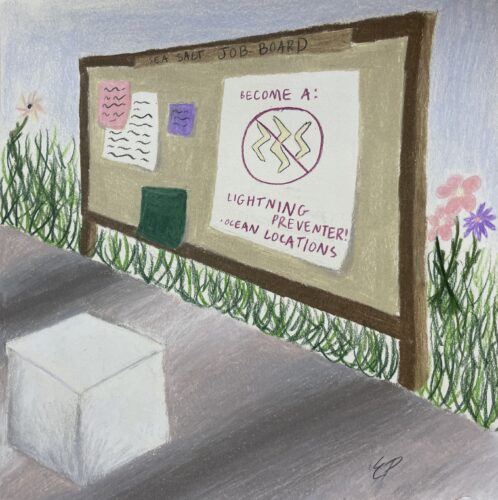Image courtesy of Emily Poag.
In Greek mythology, any site struck by lightning is considered sacred. By that logic, the Earth’s land must be divine—a whopping 90 percent of lightning strikes land, leaving only a measly ration for oceans worldwide. Thanks to a study recently published in Nature Communications, we now know the secret to this phenomenon. Above the ocean, wind and water interact to form sea spray: salty particles suspended in the air. Scientists in Israel, China, and the US discovered that this spray could reduce lighting by up to 90 percent.
Clouds are composed of droplets that typically form when water vapor condenses onto aerosols. The term ‘aerosol’ refers to any small solid particle suspended in the air. Previous research found that ‘fine aerosols,’ such as smoke, can encourage lightning formation by serving as sites for condensation. This has been used to link rising rates of air pollution to increased lightning.
“Lightning is sort of the byproduct of clouds,” said Yannian Zhu, study co-author and associate professor at Nanjing University. “Normally, if you don’t have clouds, you don’t have lightning.”
For clouds to become ‘electrified,’ they must reach a certain elevation. Rising currents of air—updrafts—help clouds grow to a height at which the temperature is below zero degrees Celsius. At this level, water droplets can freeze into ice crystals. Some of these ice crystals then collect the rest of the water droplets, forming larger sleet-like particles known as ‘graupel.’ The other ice crystals remain small and positively charged and continue to be pushed by updrafts toward the top of the cloud. Meanwhile, the graupel descends, carrying a negative charge. Electrical charge is transferred from the crystals to the graupel when they collide. Over time, an electrical field builds from the constant transfer of electrical charges between the oppositely charged particles. After sufficient buildup, the power of the electricity is strong enough to penetrate through the atmosphere, discharging as a flash of lightning.
On land, fine aerosols are much more concentrated, largely due to air pollution, making them the main source for cloud formation. Over oceans, sea spray frequently serves as a condensation site, forming water droplets bigger and heavier than their fine aerosol counterparts.
Fine aerosol particles are small and abundant, forming clouds with numerous small droplets. These droplets are slow to combine into raindrops, remaining small enough to ascend easily to a high enough level for freezing to occur. However, sea spray, which is considered a ‘coarse aerosol,’ has the opposite effect: large droplets form and quickly coalesce into rain.
The large salt particles in sea spray can absorb water quicker and easier, forming large droplets that eagerly collect other droplets. As a result, these clouds will rain out too soon before reaching the sub-zero temperature height at which ice can form and electrify the cloud. This phenomenon also helps explain why small rain showers are more frequent over the ocean than on land.
“If you live beside the sea, you will see that there are many [rain] showers every day without thunderstorms—just showering,” Zhu said. “It is a cycle, water vapor becomes clouds, and then the clouds become rain [and so on] … this energy transition between surface and atmosphere is very fast.”
The researchers drew upon over four years of satellite data measuring clouds, precipitation, aerosols, and meteorology. “In principle, people knew that the added sea spray particles enhanced rainfall, but they never had such comprehensive measurements from satellites to actually [demonstrate] the effect on a global scale,” said co-author Daniel Rosenfeld, a meteorologist and professor at the Hebrew University of Jerusalem. “It’s one thing to know that something, in theory, could happen; it’s another thing to see that it is [in fact] really significant and has a large effect.” This study ultimately differentiated the contrasting effects of fine and coarse aerosols on clouds.
Current weather prediction and climate models fail to consider the effect of sea spray on weather patterns. Knowing how aerosols can change the cloud’s physical processes will enable us to monitor convective clouds more accurately and potentially artificially alter them to avoid natural disasters, such as hail and tornadoes. Simply by deploying the right aerosols into the air, the practice of ‘cloud-seeding’ has facilitated China’s attempts to trigger more rainfall for agriculture.
“Our responsibility is to understand the whole aerosol-cloud interaction microphysical process and to give that knowledge…to help people do future climate predictions more accurately,” Zhu said. “We’re trying to save the world in a different way.”

